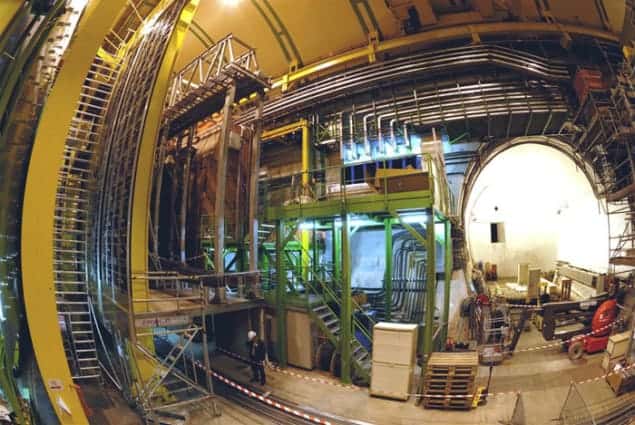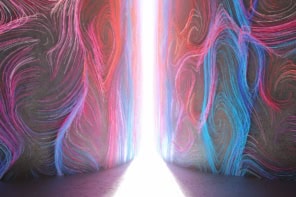
The first definitive observations from a single measurement of D-mesons “flipping” or oscillating from matter to antimatter have been made by researchers on the LHCb experiment at CERN, Geneva. Previous experiments have seen evidence for the same oscillations but the individual results were not statistically significant, whereas the new LHCb result is, at 9.1σ, considerably better than the 5σ “gold standard” for a discovery in particle physics. The oscillation was predicted by the Standard Model of particle physics for four types of mesons – all of which have now been experimentally observed. This new result could lead to more detailed studies of charge–parity (CP) violation in charm mesons.
Charmed mix
One of the seven experiments at the Large Hadron Collider (LHC) at CERN, the LHCb is a b-physics experiment designed to study the physics of B-mesons – particles that contain a bottom quark or an antibottom quark. But particle collisions taking place in such experiments also produce other mesons, including the D0 – a neutral meson that consists of a charm quark and an anti-up quark. A D0 can oscillate into its antiparticle state – the anti-D0, which consists of an anti-charm quark and an up quark.
The weak interaction – one of the four fundamental forces of nature – allows for quarks to change their type or “flavour”. But neutral mesons undergo a type of second-order weak interaction – they can oscillate between their particle and antiparticle states. To dig a little deeper, inherent quantum-mechanical effects and weak interactions allow the usually degenerate D0 and anti-D0 mesons to “mix” with each other, resulting in two new superimposed eigenstates that differ slightly from the physical states of the meson and the antimeson. This mixing occurs becuase of two specific mixing parameters – that is, the two eigenstates have slightly different masses and lifetimes. It is these differences that allow for the oscillations from D0 to anti-D0 (also referred to as “charm mixing”) to take place, with a frequency related to the mass difference.
The LHCb collaboration observed the oscillations by studying the time-dependent ratio of the rate at which D0 decays into a kaon and an antipion over D0 decaying into an antikaon and a pion. The researchers determine the flavour of the D0 or anti-D0 particle at production and then once more when the particles decay, allowing them to detect the oscillation or charm mixing.
High statistics
“We can tell if the meson was produced from a D0 or anti-D0. We then look at the ratio – if mixing has occurred, then the ratio increases over time. If no mixing has taken place, the ratio remains constant,” explains Angelo Di Canto of the University of Heidelberg in Germany, who is part of the LHCb collaboration.
Di Canto explains that the LHCb apparatus has “dedicated parts that allow it to look for these [meson-decay] events and supress all the background events that mimic the states we look for”. He also points out that the number of data acquired by the LHCb is very large and that many events have been observed. As there is only a short time during which the rather slow oscillations have an effect before the particles decay, sufficiently high measurement statistics are essential for a clear result.
Violated oscillations
In late 2011 the LHCb team also found the first hints of direct CP violation in the D0 system, with an asymmetry value of approximately –0.82% – a 3.5σ result – with the data from the first year the LHC was operational. To look for further hints of CP violation, the team is now analysing its full data sample (three times the number used in the D0-mixing paper) to search for CP violation in charm mixing. “If there is a CP violation in the mixing, then there would be an increased probability of D0 to anti-D0 flips as compared with anti-D0 to D0 flips, or vice versa,” says Di Canto.
He explains that in the coming months, the researchers will split the data into the two oscillations and compare the mixing parameters in both, making sure that their results are purged of all systematic effects. Although this will result in the most precise measurement of CP violation in charm mixing so far, more statistically significant data will have to be taken after the LHCb experiment is upgraded before the team can pin down the parameters with ultimate precision. Also, since theoretically the mixing parameters are difficult to calculate, much more accurate predictions are needed before a discovery that lies beyond the Standard Model can be unambiguously identified in the experimental measurements, according to Di Canto.
“In my view, the importance of this result is that it demonstrates the capability of LHCb to make high-precision measurements in the charm sector. The results on charm-mixing parameters are about a factor of two more precise than those from any previous experiment,” says Tim Gershon of the University of Warwick in the UK, who is also the physics co-ordinator of the LHCb experiment.
Meanwhile, Di Canto says that although the Standard Model has “predicted the oscillations beautifully…it is important to keep understanding all the details of this intriguing phenomenon”.
The research is published in Physical Review Letters.



